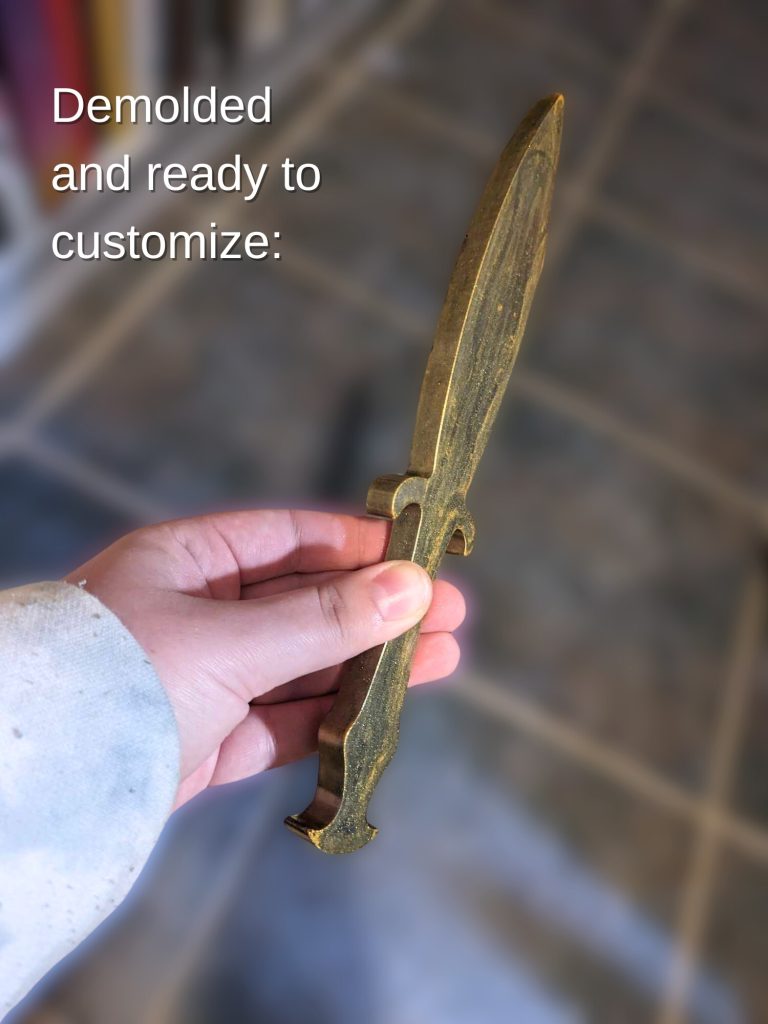
When it comes to cosplay props and accessories, you may have asked yourself, “Ooh, could I cast this out of resin?” Resin casting is undeniably trendy right now for all kinds of crafts, but is it truly worth the investment of time, money, and effort when it comes to cosplay? Let’s delve into the pros and cons of this popular technique.
The Pros
- Options Galore: Resin offers a wide range of possibilities when it comes to color and shape. Whether you want solid hues or translucent shades, there are countless methods to achieve your desired effects. The availability of varied molds opens up endless creative avenues. For example, there are molds with multiple shapes for prop daggers, allowing for versatile casting.
- Reusability: Once you have a mold, you can use it repeatedly, provided it doesn’t wear out. Resin casting offers a great way to create multiple items, such as gems for costumes, which can be used over and over again.
- Tutorial Availability: The wealth of resources available online makes resin pouring how-to knowledge accessible at all levels. YouTube tutorials and crafting forums on Facebook and Reddit offer extensive guidance, making it easy to hone your skills and troubleshoot any challenges.
- It’s Fun!: The process of mixing, designing, and demolding resin is gratifying and enjoyable. The demolding process, where you finally see your finished project, is particularly satisfying. There are even video compilations featuring artists demolding their resin items, showcasing the joy of this process.
The Cons
- Extra Work: Crafting resin props for wearable or handheld use requires more labor compared to casting resin for stationary items. It involves additional steps like smoothing sharp edges and attaching hardware, which can be intricate and require customization after demolding.
- Huge Upfront Investment: The initial investment for resin casting can be substantial. You’ll need personal protective equipment, molds, resin, pigments, and various tools, which can make it a costly endeavor. While you can buy small amounts to start, the number of required items can be overwhelming.
- Health and Property Risks: Safety precautions are crucial when working with resin. Inhaling fumes poses health risks, and some individuals may develop sensitivities or allergic reactions. The potential for burns during a flash cure is low but not nonexistent.
- Steep Learning Curve: The learning curve for resin casting can be challenging. Some people struggle with building designs upside down (a requirement for many molds), while others find it difficult to make accurate measurements or pour without making a mess.
- Space Intensive: Resin casting requires ample horizontal workspace that remains inaccessible during the curing process, which can take up to 24 hours per layer.
Our Verdict
Resin crafting for cosplay purposes is most rewarding when integrated into a broader crafting hobby or business. While it offers numerous creative opportunities, the learning and physical space commitment required may outweigh its benefits for cosplayers who are already engaged in multiple crafts for a single costume. Crayle, for example, creates resin props in between making coasters, trays, keychains, LED lamps, and jewelry for her business, Pokeballs by Crayle. Even with 12 new costumes a year per person, they haven’t found enough use for resin molds to justify the high upfront investment, health risks, and space requirements.
This isn’t meant to discourage you from learning resin casting, especially if you’re already interested. If you do want to go for it, consider reaching out to other cosplayers to see if they need resin props. You can charge for them, gift them, or trade them for other services like sewing work for a different part of your costume. If resin casting seems like too much commitment, consider commissioning resin pieces from someone already established in the craft.
Pro Tips from Crayle
If you decide to try resin casting, here are some pro tips from Crayle to help you along the way:
- Set Up Your Space: Find a large, flat workspace away from food prep areas, as resin is not food-safe. Use silicone mats to contain messes, and ensure the area is well-ventilated. Keep paper towels handy for quick cleanup.
- Personal Protection Equipment (PPE): Always wear a respirator or mask, clear goggles, and latex or neoprene gloves when working with resin.
- Research Your Project: Different resins have varying curing times and purposes. Make sure to research your exact type of project before purchasing resin to avoid mishaps like flash cures or discolored products.
- Deburr Sharp Edges: After demolding, use a deburring tool to remove sharp, raised edges. It’s safer and creates less mess than sanding.
- Be Mindful of Cloudy Outcomes: If your resin piece comes out cloudy, you can fix it by pouring a thin layer of resin over it or using clear enamel spray for a glossy finish.
- Backup Molds for Extra Resin: If you have excess resin after a project, use backup molds to create keychains or other items instead of discarding the extra resin.



With these tips and careful preparation, resin casting can be a rewarding addition to your cosplay hobby or business. Good luck, and happy crafting!
For more cosplay-making tips and awesome photos in costume, follow Phoenix Sisters Entertainment on Facebook, Instagram, or TikTok.

OR VISIT WWW.LINKTREE.COM/PHOENIXSISCOSPLAY

